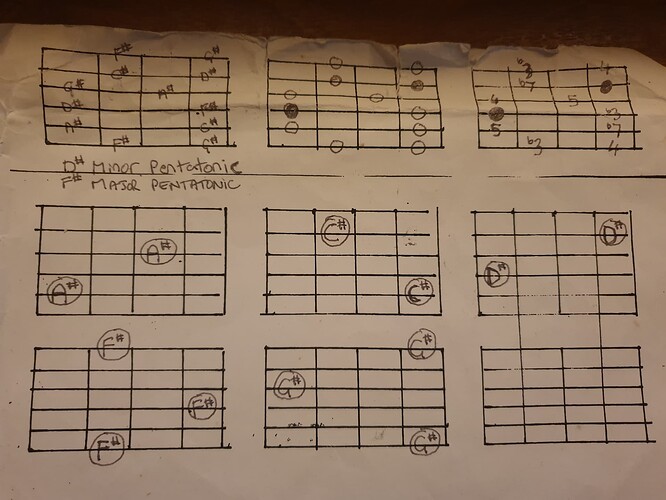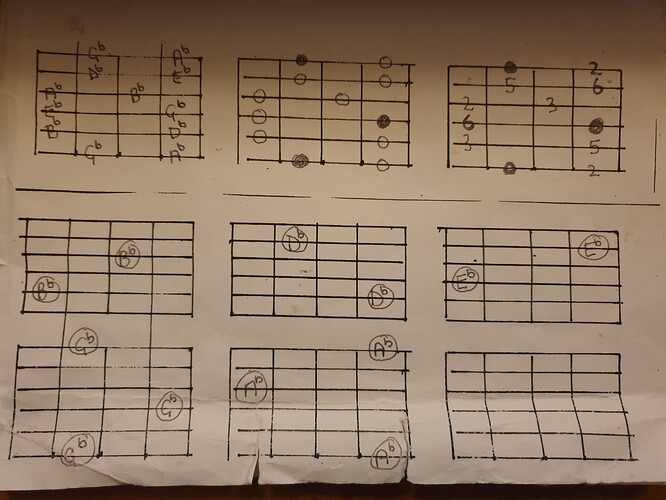Definitely lots of info in them. I haven’t gotten to looking them over well yet. Hopefully they are better than just raw info.
There’s good contextual examples and exercises well beyond the raw data. Multi modal soloing over chord progs for example.
I’m working up instrumental parts for the covers I’m doing, for instance the middle eight of the Beatle’s ‘In My Life’ which in this version runs E, Ebm7b5, C#m, E7, A, Am [x2] with just 2 beats on each chord at a moderately slowish tempo. It’s a good challenge ripping through all those quick changing arps all over the fretboard.
Definite lack of justice done there. Maybe if the application had been sent in a rainbow themed envelope there might have been a better result.
I think you mentioned something about this here before. I don’t have any experience with our immigration system, but that sounds nuts. A bit like Mexican families who end up here and maybe a parent gets deported.
The lengths I go to sometimes. I decided to keep with the original solo rendition of In My Life, there’s plenty of room for creative original gtr noodling in the rest of the repetoire. I’m tuned down a half step and play this song in the Key of Eb [at -1 tuning so the shapes played are those of E]
The original song is in A , so I learned it by playing it ostensibly in A# to the tutorial below where there’s no tabs and then converted THAT to Eb.
Took me an hour or two, then I wrote it out in TAB, took a photo of it and moved it into the appropriate folder.
On a fkn Saturday! [See possible upcoming thread on ‘professionalism’
Did any of you ever learn the notes on the fretboard to the degree that you can randomly move to any fret and you immediately know the note without hesitation for referencing other surrounding notes? Or maybe you’re playing some lick or chord and can immediately name the notes?
How I learned notes on the fretboard in the past was memorizing the natural notes per string and octaves across strings. It held for a while, but faded over time. And the notes that stuck for the long haul were the ones that are used most often.
What I’m doing now was mentioned in a youtube link above, but in summary: 1. Play a given natural note across all strings, up and back down 3 times without mistakes, for all natural notes. 2. Add in accidentals. 3. Do it with a metronome starting at 40 bpm, working it up to 80 bpm over time. 4. Play one note across strings up and another random note down.
I’m over a week into that at step 3 (not at 80 bpm), and when doing the exercises I have a good recall of all notes. Outside of the exercises though, recall is pretty slow still, needing to reference surrounding notes. So it doesn’t seem to be that effective when put to a real world test.
My initial thought is to keep doing this exercise but to add in doing per string up and down chromatic note naming, do triads in the same way, and do positional chromatic note naming across all strings and triads. My reasoning here is to make multiple mental connections, across strings, per string, positional.
I never really learned all the notes across the fretboard. I have always been more of a shape player.
I do have a good handle on where my root notes are for all the keys, and from there knowing where my triads are, but I’m pretty weak on knowing what those triad notes are beyond the root note.
I do think being able to identify all the notes, randomly, across the fretboard is a valuable tool. Good luck with your pursuit, I’m sure you’ll find it to be time well spent.
if you learn the F# Maj pentatonic or D# mi pentatonic,
those scales have all the sharp notes (or flat notes if Gb/Eb instead)
I found that was quite helpful and made sure you know your sharps and flats directly,
as opposed to referencing your altered notes from the C Maj or A mi scale notes
eg (sorry for the crumpled edges)
I also used to assign a note for each weekday to prioritize
And play from the lowest note to the highest note, and the reverse
Plus play the same note on 4 or 5 strings
Stuff you’re already doing really
I also did it with a staff at some points, but never completed that properly
Sounds like a good idea for the accidentals. Did you end up being able to name any notes on the fretboard immediately?
Maybe I just need to jump back in with playing through (and note naming) all triads, arpeggios, and modes.
Side note: It’s interesting that all accidentals make up intervals of a pentatonic.
Yep, especially in the low frets, I got sidetracked before I mapped out the higher regions
I think you can just divide the fretboard into thirds, 0-4, 5-8, 9-12, and concentrate on one area at a time before extending
That may be where I ended up too. I know well the notes on the lower end of the fretboard, fully on the two lower strings and on the two higher strings. I tend to hesitate for notes on the two middle strings past the 5th fret. I tend to automatically reference the lower octave notes on the two lower strings for the two middle strings. Maybe I need to keep thinking this out a bit, because I might not be as bad off as I think.
The logical thing then would be to just practice that,
the D and G string from frets 5-12
I went through a phase of just using the D-G-B string set,
I-iv-ii-V, I7-VI7-II7-V7, and I-IV-V
in all positions, and moving between positions,
ascending the neck, and descending
There’s so many combinations you can use when you restrict it to 3 notes,
it really helps with voice leading I think
I think ultimately all guitar players are shape players. It is good to know the notes when working out theory things. And of course it’s good for reading music. But on reading music, I have seen more than one mention from proficient sight-readers that they read in intervals of the key, mapping to intervals of positions on the fretboard, not so much reading note names directly and playing named notes directly. One jazz player described it as reading and playing memorized shapes for chords and interval contours for lines.
Yea, it’s maybe figuring out a minimal number of them to be effective.
Pulling note names out of my ass is contextual I think. When doing certain things, I’m so focused into a small area of the fretboard that previously memorized schemas are outside of that picture, which is where the hesitation comes in for switching context. For example, when thinking about the notes in a lick, the context is positional, not of the schema of a same note name across all strings. Or when playing on a single string, having notes memorized positionally might require a context switch. Maybe it’s just a matter of time though. I tend to be impatient.
This might seem rambly on a small point…
The original exercises of learning the notes on the neck that I started with this time around takes the approach of blindly playing a single note across every string, up and down, until it’s easy at 80 bpm. I have pretty well gotten there, just needing maybe a few more days to be really confident with it. But something that I noticed along the way for myself is that recalling notes in this way is partially contextual to doing the exercise, not fully transferring outside of the exercise, at least not immediately. Something that I have arrived at in the last couple of days is that when jogging through a given note across all strings, I start to wonder ‘why’ I am playing a note at a given fret. Or in other words, while doing the exercise the context of the surrounding notes is thrown away. So I have began to stop at that point in the exercise and get a good feel for the surrounding notes of a given note at a given fret. Then I jump back into the exercise, and my confidence in ‘why’ I’m playing that note is solid. So for example, if I’m playing through Db across all strings, I get to the 6th fret on the G string, and my mind starts to wonder in thinking about that position, I stop and think about it for a moment. Ok, I know C well on the 5th fret, D is on the 7th fret, Ab is on the same fret on the D string…. And I play a bit among the surrounding notes in that area for a moment while thinking about the note names. I guess you can call it context building, for having confidence in ‘why’ Db is at 6th fret on the G string. And then I jump back into the exercise at 80 bpm, and all is good.
So I guess what I’m saying is that I somewhat disagree to the approach of the exercises that I’m doing. I think it’s fine to begin doing the exercises blindly. But as the mind loses confidence in a particular position for a particular note, it doesn’t make sense to just keep playing the exercise blindly. At that point it is good to stop and build some surrounding context for confidence. Then jump right back into it. And so I also think that for this exercise to transfer well to the real world, it’s good to build all these little contexts. It seems so trivial. Of course Db is just one fret after C, etc. But blindly doing an exercise without stopping to recognize what other notes are in the immediate vicinity seems to be building a wrong-headed approach to knowing note positions (without surrounding context) and creating unnecessary small moments of stress while doing the exercise (blindly playing notes without rock solid confidence). Just stopping to think for a moment and having a short play around of the surrounding notes gives confidence in what is being played and glues things together, which should transfer well outside of the exercise.
Also, one example of why it is good to know the notes on the neck is for easily creating alternate chord fingerings for chords. Guitar players tend to learn standard chord shapes and stick to those, at least at the intermediate level. But sticking to memorized chord shapes can sometimes create unnecessary jumps in position or musical jumps in leading from one chord to another. Having the ability to easily rebuild a chord in the same position as another played chord or to transition the notes of one chord into the notes of another chord can be really nice for playing ease or musicality.
Some teacher, I can’t remember who, stated he didn’t practice exercises anymore
If there was a technique or note selection he needed to practice, he’d compose a lick using it, and practice that instead
The theory being its easier to remember accurately something musical, as opposed to non-musical, and its imnediately useful in your playing somewhere, whereas you cant use exercises in your playing mostly
Satriani said a similar thing,
when he wanted to assimilate a new mode, he’d write a song around it
Another tip,
when you write out fretboard chords or scales,
write the actual note in, instead of a circle
I would go further and use different colours for the chord tones
It all helps see the fretboard clearer


